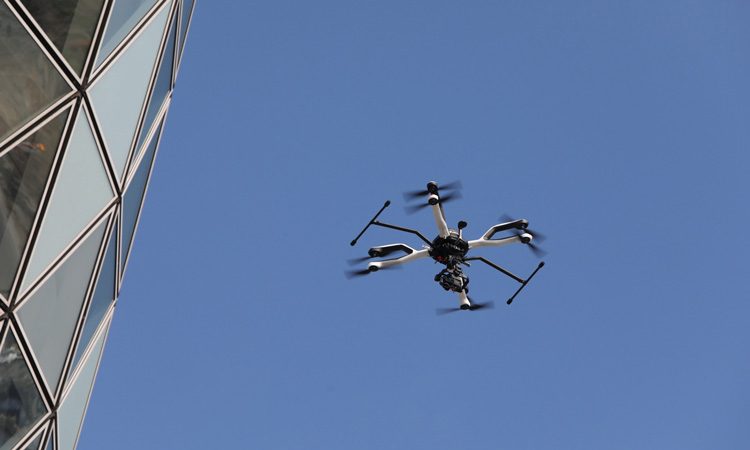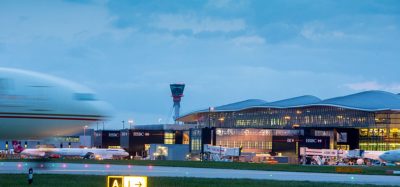Making drone activity safe in the skies above Europe
Posted: 26 June 2019 | Florian Guillermet (SESAR Joint Undertaking) | No comments yet
Research and innovation is underway in SESAR – the technological pillar of the Single European Sky – to ensure that increasing drone traffic in Europe’s skies can be managed safely, in particular in relation to commercial air transport. Florian Guillermet, Executive Director of the SESAR Joint Undertaking, tells us more.


Drones are rapidly becoming part of daily life: They provide effective infrastructure inspection and maintenance tools; they carry out photographic and survey functions; and they support emergency services. The European Drones Outlook Study1 estimates as many as 400,000 drones will be providing services in low-level airspace by 2050, and a total market value in excess of €10 billion annually by 2035. A robust framework that supports commercial and leisure operations will be essential to support the investment already underway by industry and operators. Airports in particular will need to invest in equipment to protect against rogue drones, whilst ensuring commercial operations.
The European Commission recognised the need to provide a safe and secure environment for drone operations when it launched its U-space initiative in the ‘Warsaw Declaration’ of November 2016. U-space is a set of services and procedures relying on a high level of digitalisation and automation of functions to support safe, efficient and secure access to low-level airspace for a large number of drones. It provides an enabling framework to support routine drone operations below 120m and addresses missions including operations in and around airports. Ultimately, U-space will enable complex drone operations with a high degree of automation to take place in all types of operational environments.
Drones are rapidly becoming part of daily life: They provide effective infrastructure inspection and maintenance tools; they carry out photographic and survey functions; and they support emergency services. The European Drones Outlook Study1 estimates as many as 400,000 drones will be providing services in low-level airspace by 2050, and a total market value in excess of €10 billion annually by 2035. A robust framework that supports commercial and leisure operations will be essential to support the investment already underway by industry and operators. Airports in particular will need to invest in equipment to protect against rogue drones, whilst ensuring commercial operations.
Join us live: Shaping the Next Generation of Hold Baggage and Air Cargo Screening
Join us live for an insightful webinar on 11th December at 14:00 GMT, in collaboration with Smiths Detection, as we explore the strategic balance of operational efficiency, regulatory compliance, and sustainability in high-volume security environments.
This session offers a focused look into future-proofing your security strategy.
Key learning points
- Cost Reduction: Strategies to minimize bag travel time while simultaneously reducing operational costs.
- Regulatory Roadmap: Insights into the next wave of regulatory changes and their impact on future investment decisions.
- Sustainable Systems: Practical approaches to building sustainability into security systems and lowering the total cost of ownership (TCO).
- Scalable Solutions: Real-world examples of scalable systems supporting current airport growth and preparing for tomorrow.
Register now for expert insights, case studies, and actionable strategies on operational efficiency!
The European Commission recognised the need to provide a safe and secure environment for drone operations when it launched its U-space initiative in the ‘Warsaw Declaration’ of November 2016. U-space is a set of services and procedures relying on a high level of digitalisation and automation of functions to support safe, efficient and secure access to low-level airspace for a large number of drones. It provides an enabling framework to support routine drone operations below 120m and addresses missions including operations in and around airports. Ultimately, U-space will enable complex drone operations with a high degree of automation to take place in all types of operational environments.
U-space building blocks
The launch of U-space set in motion a series of activities across Europe directed towards the development of appropriate rules and regulations, technical and operational requirements capable of supporting future autonomous operations. The SESAR Joint Undertaking (SESAR JU) is very much part of this pan-European effort, having received the mandate from the European Commission to coordinate all research and development activities related to U-space and drone integration.
In 2017, we released the U-space Blueprint2, setting out the vision and steps for the progressive deployment of U-space services from foundation services, such as flight planning, flight approval and tracking, to more complex operations in dense airspace requiring greater levels of automation and connectivity. Building on this, we created a roadmap for the safe integration of drones into all classes of airspace3 which outlines the steps needed for a coordinated implementation of solutions to enable larger drones alongside commercial airspace. The roadmap will be included in the next edition of the European ATM Master Plan4, to be published this year.
We then launched a series of exploratory projects with funding from the EU’s Horizon 2020 budget, addressing the concept of drone operations, critical communications, surveillance and tracking, information management, aircraft systems, ground-based technologies, cyber-resilience and geo-fencing. These capabilities enable the progressive deployment of services over time, starting in 2019 with U-space foundation services. The projects bring together an unprecedented number and range of actors from traditional aviation, but also new entrants, including start-ups, SMEs, research institutes, universities, drone operators as well as service providers, airports, local/city authorities, law enforcement agencies and civil aviation authorities.
Full speed ahead
In 2018 we launched a series of demonstration projects, co-funded by the European Commission’s Connecting Europe Facility in order to show the maturity of the services and capabilities emerging from our research projects. New players with knowledge of autonomous operations and mobile communications participate alongside SESAR JU, EASA, industry players and standards agencies. Running until the end of 2019, this enlarged SESAR family of stakeholders have programmed a series of demonstrations in several cities and rural locations in Belgium, Estonia, Finland, France, Greece, Italy, the Netherlands and Spain.
Together these demonstrations aim to show the readiness of U-space services to manage a broad range of drone operations and related applications, and their interaction with manned aviation. These range from parcel deliveries between two dense urban locations, medical emergencies and police interventions, as well as air taxi trials between airports and nearby cities. The leisure user is also catered for, with projects demonstrating how private drone operators can benefit from U-space services.
Demonstrators are also taking place outside SESAR. To bring in this broader pool of activities and speed up the deployment of drone services, the European Commission launched the European Network of Demonstrators in October 2018. The network establishes important links with regulatory bodies, such as EASA, tasked by the Commission with drafting rules to govern the safe integration of drones into manned airspace. The SESAR JU research and demonstration help identify the operational requirements needed for this regulatory framework. We also work closely with the European standards agency, EUROCAE, and support wider standardisation work by ICAO, in particular ICAO’s Standards and Recommended Practices (SARPS) for drones operating in manned airspace due for implementation in 2023.
EASA regulation will be critical for the expansion of the drone service market since it will create a common EU market for drones by harmonising operations across Europe. The European Commission adopted EASA’s proposed regulations in March 2019, and new rules are due to come into force in 2020, subject to approval by the European Parliament. These classify drones into several main categories based on performance and capability, allowing EASA to conduct specific operation risk assessment (SORA) for the different categories, and develop guidance material that helps drone operators comply with regulations.
What does this mean for airports?
Airports are taking short-term measures to mitigate drone intrusions, from grounding aircraft when drones are detected to reducing speed of aircraft on approach in order to limit damage in the event of a collision. Drones therefore have significant impact on the punctuality and the overall capacity of the airport. In the long term, dealing with drones requires airports to look at systems that will help them to detect, survey, identify drones or enforce trajectories as well as enable the geo-fencing of the airspace around the airport.
SESAR research is delivering solutions which address these challenges. For instance, partners in the CLear Air Situation for uaS (CLASS) project are looking at a combination of technologies to merge data coming from both cooperative and non-cooperative surveillance sources to enable conflict detection and resolution, and protection of restricted areas like airports. The CLASS project tested drone detection and tracking technologies during live demonstrations, which took place at the Deenethorpe Airfield (UK) in late 2018. The project performed 40 flights and six scenarios in total, which showed how the CLASS system can track and display in real time both cooperative and non-cooperative drones. The resulting system will provide the basis with which to develop U-space services tailored to end-users, including airports. Advanced services include tactical geo-fencing (where the drone pilot is warned automatically if he trespasses into an unauthorised zone), geo-caging (where the drone pilot is warned that he is leaving a pre-defined zone), conflict detection and resolution.
Another project is the PODIUM demonstration, which is performing 18 operational scenarios, for beyond visual line of sight (BVLOS) and VLOS flights, across five sites including Groningen Airport Eelde, Hans Christian Andersen Airport Odense, Rodez-Aveyron Airport and the Drones Paris Region cluster in the vicinity of the Orly CTR. Drone operators and air traffic controllers are actively using U-space services for both the flight preparation and flight execution phases. Thanks to these live demonstrations, the PODIUM project is gaining valuable feedback, as well as recommendations for future improvements.
Seamless integration
At the same time, drones could represent new revenue streams for airports, especially drones transporting freight. Recognising this potential, the SESAR VUTURA demonstration in the Netherlands is trialling the delivery of packages to and from Twente Airport, while partners in the EuroDrone demonstration will show the feasibility of small express parcel delivery between an airport and the post office in a nearby city. The transport of passengers also holds potential, which partners in the Gulf of Finland demonstration will put to the test with trials taking place later this year.
In addition to small drones, airports need to consider large certified remotely-piloted aerial systems (RPAS) and their integration with manned aircraft, especially in the approach segment around airports. SESAR is testing cargo RPAS vehicles inserted into the airspace alongside commercial traffic to assess how controllers manage the traffic mix and deal with particular RPAS requirements. This work is done closely with the European Defence Agency (EDA) to ensure RPAS can be accommodated in non-segregated airspace despite being equipped differently and often operating at lower speeds than manned aircraft. RPAS also need access to the airport surface where they are subject to the same rules, procedures and performance requirements as any other airport user. They must be able to interface with ground-based airport systems and demonstrate their ability to act and respond to air traffic control.
On the horizon
Looking to the future, the U-space framework will accommodate all types of aerial systems, from manned aircraft to RPAS and drones, within one transparent system. With the appropriate services, regulations and procedures, U-space will allow the airspace management environment to evolve together in a safe and secure way. Successful and timely roll-out will need sustained commitment of all stakeholders in the aviation and drone communities, especially airports.
References
- European Drones Outlook Study https://www.sesarju.eu/sites/ default/fi les/documents/reports/ European_Drones_Outlook_ Study_2016.pdf
- U-space Blueprint https://www. sesarju.eu/u-space-blueprint
- Roadmap for the safe integration of drones into all classes of airspace https://www.sesarju. eu/node/2993
- European ATM Master Plan https://www.sesarju. eu/masterplan
Biography
Florian Guillermet was appointed as Executive Director of SESAR Joint Undertaking in April 2014 and is responsible for leading the public-private partnership, which is modernising Europe’s air traffic management system. Guillermet has worked in the civil aviation field for 20 years. He is an engineer and graduate of the École polytechnique and Civil Aviation Engineering School in France and has a Master’s degree in Aeronautics and Airport Management.
Join our free webinar: Transforming Airport Security – Innovation, Impact, and the Passenger Experience
The landscape of airport security is undergoing a profound transformation, driven by evolving threats, technology, and passenger expectations. This webinar focuses on how AtkinsRéalis has been transforming security processes at some of the world’s busiest airports with smarter, more adaptive solutions.
Date: 4 Nov | Time: 14:00 GMT
REGISTER NOW TO SECURE YOUR SPOT
Can’t attend live? No worries – register to receive the recording post-event.
Issue
Related topics
Air traffic control/management (ATC/ATM), Capacity, Drones, Regulation and Legislation
Related organisations
European Aviation Safety Agency (EASA), European Commission (EC), SESAR

















